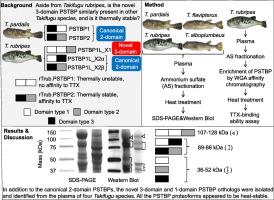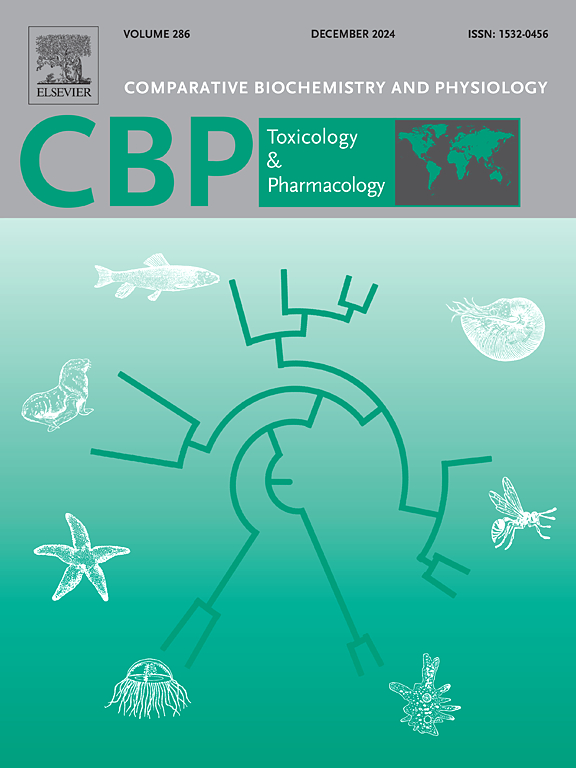Comparative biochemical characterization of pufferfish saxitoxin and tetrodotoxin-binding protein (PSTBP) homologs in the plasma from four Takifugu species: Conservation of heat-stable PSTBP orthologs having three and two tandemly repeated lipocalin domains in genus Takifugu
IF 3.9
3区 环境科学与生态学
Q2 BIOCHEMISTRY & MOLECULAR BIOLOGY
Comparative Biochemistry and Physiology C-toxicology & Pharmacology
Pub Date : 2024-09-24
DOI:10.1016/j.cbpc.2024.110049
引用次数: 0
Abstract
To study the relationship between domain characteristics of pufferfish saxitoxin and tetrodotoxin binding protein (PSTBP) proteoforms and their thermal stability, a comparative biochemical characterization of PSTBPs from the plasma of four Takifugu species (T. flavipterus, T. pardalis, T. alboplumbeus and T. rubripes) was conducted by Western blot analysis. The heat-tolerance tetrodotoxin (TTX)-binding ability of PSTBP proteoforms in T. rubripes plasma was verified by ultrafiltration and liquid chromatography tandem mass spectrometry (LC-MS/MS). These results suggest that the heat-stable PSTBP proteoforms, composed of three and two tandemly repeated lipocalin domains, are genetically conserved and ubiquitous in the genus Takifugu. This study builds on our knowledge of the structural and functional properties of PSTBP proteoforms, which is vital for understanding how toxins are transmitted and accumulate in organisms and is essential for evaluating the potential risks of toxins in seafood.

河豚毒素和河豚毒素结合蛋白(PSTBP)同源物在四种泷鱼类血浆中的生化特性比较:具有三个和两个串联重复脂质体结构域的热稳定PSTBP同源物在泷鱼属中的保守性
为了研究河豚沙司毒素和河豚毒素结合蛋白(PSTBP)的结构域特征与其热稳定性之间的关系,研究人员采用Western印迹分析法对四种河豚(T. flavipterus、T. pardalis、T. alboplumbeus和T. rubripes)血浆中的PSTBP进行了比较生化鉴定。通过超滤和液相色谱串联质谱法(LC-MS/MS)验证了红蝮蛇血浆中 PSTBP 蛋白形式的耐热河豚毒素(TTX)结合能力。这些结果表明,热稳定的 PSTBP 蛋白形式由三个和两个串联重复的脂褐素结构域组成,在泷蛙属中具有遗传保守性且无处不在。这项研究丰富了我们对 PSTBP 蛋白形式的结构和功能特性的认识,这对于了解毒素如何在生物体内传播和积累至关重要,对于评估海产品中毒素的潜在风险也至关重要。
本文章由计算机程序翻译,如有差异,请以英文原文为准。
求助全文
约1分钟内获得全文
求助全文
来源期刊
CiteScore
7.50
自引率
5.10%
发文量
206
审稿时长
30 days
期刊介绍:
Part C: Toxicology and Pharmacology. This journal is concerned with chemical and drug action at different levels of organization, biotransformation of xenobiotics, mechanisms of toxicity, including reactive oxygen species and carcinogenesis, endocrine disruptors, natural products chemistry, and signal transduction with a molecular approach to these fields.

 求助内容:
求助内容: 应助结果提醒方式:
应助结果提醒方式:


